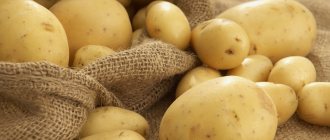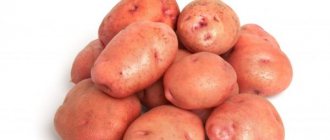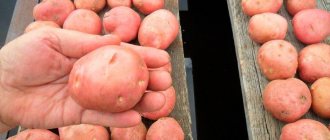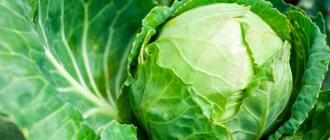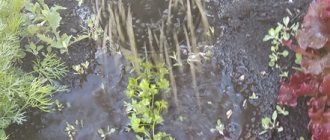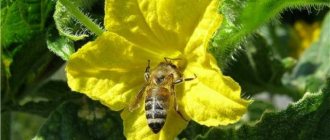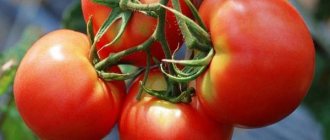Potatoes remain firmly in the forefront of familiar and most commonly consumed products. Over the long history of the appearance of this vegetable on the European continent, through the efforts of breeders, many varieties have been created.
Particular attention should be paid to the early-ripening Leader potato, which was created through selection by employees of the State Scientific Institution of the Ural Research Institute of Agriculture as a table variety, and included in the register for the West Siberian region. Later, the patent for the Leader variety was purchased by Agro.
Description and characteristics
Potato Leader has established itself as an unpretentious and high-yielding early-ripening variety. It is most common in Russia, Ukraine and Moldova. Main characteristics of the Leader variety:
| Requests | Characteristic |
| Roots | |
| Tuber | Oval-round |
| Peel | Yellow, smooth |
| Eyes | Small |
| Pulp | White |
| Weight | 88-119 g |
| Starch content | 12–12,2% |
| Plant | |
| Bush | Semi-erect, intermediate type |
| Top height | Medium, reaches 1 m |
| Sheet | Medium size, green, intermediate, little or no edge wavy |
| whisk | White, medium size |
Potatoes of this variety are propagated by tubers or parts thereof. The bush does not grow to the sides, and the tubers form and form together.
The leader has high yields, the highest were achieved in the Tyumen region - 339 c/ha.
The Leader variety is used for industrial and table needs. Starch and chips are made from it; it is used to prepare both the simplest dishes and complex ones that can satisfy the taste of the most demanding gourmet.
Varieties of red potatoes with yellow flesh
It is difficult for every gardener to choose the right potato variety among the large number of varieties of yellow-fleshed vegetables. Below you can find the most popular varieties that are characterized by high yields.
Bellarosa (may be called Bella Rose or White Rose)
Bella Rosa is an early variety of vegetable crop, which is distinguished by pleasant taste characteristics and high yield levels.
The variety does not require systematic soil moisture. The crop variety can tolerate prolonged dry periods well. Root crops can be planted in any type of soil.
Agronomists recommend applying fertilizers to the soil, which will help increase the yield. White rose is not susceptible to nematodes and potato cancer.
Tubers tolerate transportation well over long distances. A significant advantage of potatoes is the lack of predisposition to overcooking, which allows the product to be used for preparing first courses, salads, French fries, and chips.
Condor
A mid-early variety of table potatoes. The shape of the tubers is long, oval.
The variety tolerates drought and can easily adapt to any climatic conditions.
The condor is not susceptible to late blight, potato blight, fusarium and common scab. The growing season is between 75-90 days.
Red Scarlet
An early variety of vegetable crop, which has an average yield and satisfactory taste. Red Scarlet should be grown in soil with good breathability.
It is advisable to select root crops with 5 eyes for planting. Even in the absence of frequent soil moisture and weeding, the yield level does not fall. The formation of red potato tubers with yellow pulp is simultaneous.
Red Scarlet is not susceptible to diseases such as potato canker, but is often affected by late blight. The pulp does not darken after removing the skin.
Red Scarlet
Rodrigue
The ripening period of the Rodrigue vegetable crop reaches 80 days. The mid-late variety of potatoes has a high yield level. With proper care, you can collect 400-500 centners of crop from each hectare.
The pulp can be colored white or yellow. The weight of each fruit is 700-800 g. The Rodrigue variety has no disadvantages. Gardeners can grow tubers in any climate.
Among the main advantages of the mid-late variety of potatoes, it is worth highlighting:
- the presence of a minimum number of eyes on root crops;
- the ability to use the crop to make French fries and chips;
- the commercial appearance of the tubers, which is achieved due to the dark red color of the potatoes.
Advantages and disadvantages
Leader potatoes have many advantages, which sets them apart from numerous table varieties. The disadvantages of potatoes in comparison with its positive qualities are insignificant.
| Advantages | Flaws |
| Wide range of uses | Vulnerability to pests (Colorado beetle, nematode, wireworm and mole cricket) |
| High yield | Lack of moisture negatively affects the harvest |
| Multituberism | Hilling requirement |
| Disease resistance | |
| Good transportability | |
| High taste qualities | |
| Long-lasting shelf life of tubers |
Landing
It is best to prepare Leader potatoes for planting during the harvesting process. The main criteria for choosing planting material:
- medium size potatoes;
- a large number of eyes;
- healthy, undamaged tuber.
It is advisable to turn the tubers green by keeping them in a lighted place for some time, this protects them from rodents and pests. Store potatoes at a temperature of 11-16C°.
Important! The choice of small tubers for planting leads to low yield and extinction of the variety.
Before planting, Leader potatoes are germinated. The process lasts about a month. There are several ways to do this:
- the tubers are laid out on the floor;
- potatoes are sprouted in sawdust;
- planting material is placed in plastic bags with ventilation holes;
- tubers are placed in wooden boxes.
Sprouted tubers are planted in open ground at the end of early May. The planting pattern is 60x35 cm, planted to a depth of 8-15 cm. If the soil is loose, the planting depth increases to 20 cm.
Ash is a good fertilizer for Leader potatoes. It can be added to the soil in the fall, or you can sprinkle it on the tubers when planting. Planting Leader potatoes is recommended on land where winter crops, perennial grasses or flax previously grew.
Important! When fertilizing, it is better not to use fresh manure. It can become the causative agent of many potato diseases.
Features of cultivation
Leader potatoes have received reviews in all corners of the Russian Federation, and all thanks to their unpretentiousness. It appealed to many summer residents and farmers.
In warm regions, this variety is planted at the end of April, and in the northern parts of the country - in early May. By this time, the earth will warm up to the required temperature (+8-10 degrees). Before planting, it is recommended to germinate Leader by selecting medium-sized tubers with the largest number of eyes. They are left in a warm, lighted room for 2-3 weeks.
The variety is not picky about soil, but some recommendations are still worth considering. In light soils, seed material is placed 15-20 cm from the surface, and in heavy soils it is better to plant it in holes of shallower depth.
After planting, standard agrotechnical measures are carried out. This includes:
- loosening the soil;
- weeding to get rid of weeds;
- hilling;
- watering;
- fertilization;
- combating insect pests and crop diseases.
If the Leader is left without proper care, its yield will noticeably decrease, and the quality of the tubers will not be up to par. Proper organization of work and compliance with all rules of agricultural technology will allow you to grow a large harvest of these potatoes with high taste characteristics.
Care
The Leader variety is unpretentious, but you still need to follow the basic rules of care:
- watering;
- hilling;
- feeding
Watering potatoes Leader depends on the region. In areas where summers are hot and dry, watering is done once a week; in areas with more moderate climatic conditions, once a month will be sufficient.
Leader potatoes experience the greatest need for moisture before flowering and directly during the flowering process.
Hilling and feeding
Hilling is no less important than watering. It consists of shoveling soil from the rows onto a potato bush. The process is carried out after watering or rain, it is important that the soil is moist, this forces the tubers to sprout new underground shoots, on which the crop is formed.
Such manipulations also protect the Leader’s seedlings from frosts, which often occur in May. The hilling procedure is usually carried out twice:
- when the height of the bush reaches 13-17 cm;
- before flowering potato bushes.
The Leader variety can do without fertilizers, but if the soil is poor, then it is better to feed it.
| Deadlines | Fertilizer |
| The appearance of the first leaves | Mullein or bird droppings solution |
| Potato flowering period | Urea or ash solution |
| A month before digging up the tubers | Foliar fertilizing with superphosphate |
Some tips and recommendations from the author of the video:
Carrot. Which variety should I choose?
Marina Mariam
“blunt-nosed, long, large, smooth and bright red” - this is the Children’s variety. On top of everything else, it is very sweet and super juicy. Nantes is also okay, but it’s orange and not as juicy compared to Children’s.
Elena Orlova
everything on the ground, for example, no one grows Nanskaya in a dacha village, even if it cracks, but hybrid varieties grow well for me, Canada, Nandrin, Samson, try Samson and Nandrin are blunt-nosed
Goldfish
I like Nantes. My neighbor next door buys manure every year. We usually plant carrots at the same time, she with manure, I with sand. In a month and a half we have a competition to see who has more, mine is not inferior at all, and there are even more
I liked the Queen of Autumn the most. Photos in my world.
Baikalochka
I always buy different names of carrots. Plant several varieties one year, choose according to your taste. The quality of the harvest also depends on proper care. If you live in the European part, then do not get carried away with HYBRID varieties of carrots.
I plant Nandrin, Pharaoh, Sweetheart, Samson
I liked the variety - Children's, very juicy and the Canada variety.
Nataly Sitko
This year I planted gourmet and sweet tooth for the first time—I initially thought that different producers called the same variety differently—no, they are different varieties—sweet tooth is less sweet than gourmand—sweet tooth is 2 times shorter and blunt-nosed—I also don’t like cone-shaped ones— but I liked the gourmet - it’s not a cone or blunt-nosed - it’s so tasty that it doesn’t matter what kind of nose it is - and it’s sooo long - the length of a spade bayonet
Elena Smirnova
I always sow Nantes, but this year my neighbor shared the already soaked seeds (she still had them). He always mixes seeds of different varieties and sows them in the same bed. Don’t ask why, I don’t know and haven’t gotten a clear answer. So, in this “mixed” bed the carrots turned out better than in the others.
The King of Autumn or the Queen of Autumn will suit your desire. I plant them. They grow 20-25 centimeters long. Although not very blunt-nosed. But orange. And this year my neighbor praised the Autumn Tale (one to one, although it’s not long).
KostyukovaCanes.
In 12, I planted a little and the small ones grew. I was very happy about everything. its for the first time. Now I bought carrots on a ribbon, red carrots without a core and the red giant (biotechnics) Russian size 30 cm grows. And polar carrots, round cranberries - these are northern vegetables (especially early and resistant) so I wrote out a lot..)) markings.
Yulia Sokolova
You need to plant zoned varieties of your region. Each region has its own carrots that will produce well.
I bought the carrots I liked at the market from the machine of an experienced seed farm in the spring of 3 years ago, planted them, and received the seeds. Now I’m just planting it, I don’t even know the name, because they told me they haven’t come up with the name yet, they bred it themselves. Sweet
Diseases and pests
Leader potatoes are resistant to the most common diseases, such as dry rot, spotting, rhizoctonia, and blackleg. But Leader is quite susceptible to late blight.
To prevent disease, the soil is treated in advance with Bordeaux mixture; a solution of copper sulfate can also be used for these purposes, then the bed is dug up. Or they directly spray the Leader’s tubers themselves with preparations containing copper sulfate.
For a good potato harvest, Leader will have to fight pests.
| Pests | Fighting methods |
| Colorado beetle |
|
| Medvedka |
|
| Nematode |
|
| Wireworm |
|
Timely implementation of such preventive measures helps prevent not only the appearance of pests, but also many potato diseases:
- digging up soil;
- loosening the soil;
- weed removal;
- periodically changing the place where potatoes are planted;
- pre-treatment of planting material.
Harvesting
Potato Leader is an early variety. The first tubers are dug up already 45 days after the appearance of the first shoots, final maturity occurs 70-75 days after germination of the planting material. On average, 18-20 tubers are harvested from one bush. Harvesting occurs depending on the planting time, usually in July or early August.
An indicator of the degree of maturity of root crops is the drying of the tops. But it is best to dig up several bushes to assess the density and thickness of the peel. It should not peel or flake off easily, as happens on young tubers.
A dry and clear day is chosen for harvesting. After digging up the potatoes, the area is harrowed, which allows you to pick up the remaining tubers. The selected potatoes are dried and sorted, selecting diseased and damaged tubers. The harvest is stored in a dry, cool and dark place. Good keeping quality allows it to be stored without deterioration in sowing qualities until June.
